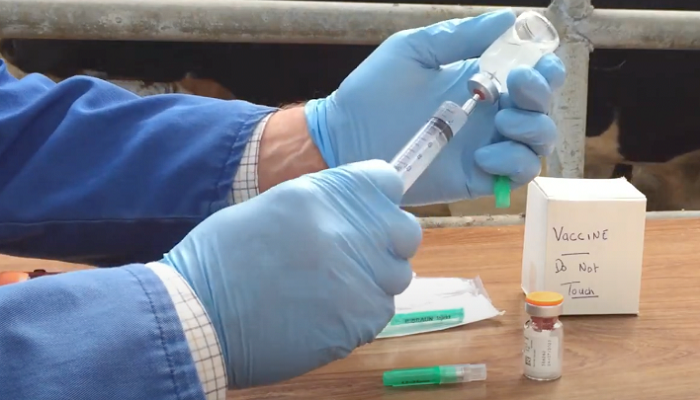Vaccination programmes for dairy-beef farms

Vaccination programmes for dairy-beef farms (PDF)
Numerous challenges to calf health are encountered in the early stages of
the animal’s life. When an animal becomes ill, treatment with antibiotics
is often needed. The overuse and misuse of antibiotics in livestock is
contributing to the rise of antimicrobial resistance in both animal and
human medicine.
Antimicrobial resistance (AMR)
What is AMR?
- AMR occurs when organisms such as bacteria and parasites develop resistance to antimicrobial treatments thus making the treatment ineffective.
- AMR is a major future risk to current everyday medicines in agriculture and human health.
How can we stop AMR?
- Focus on preventing disease outbreaks with vaccinations and biosecurity.
- Seek veterinary advice for treating disease outbreaks.
- Avoid using antibiotics to prevent disease unless advised by a vet.
- Ensure correct administration of antibiotics and always finish the course prescribed.
Pneumonia
Pneumonia is the most common disease associated with housed calves.
- Mortality rates due to pneumonia are approximately 3% in calves in the first 12 weeks of life.
- The cost of treatment, loss in performance and time cost due to pneumonia can heavily reduce farm efficiency and profits.
- Pneumonia is a multifactorial disease – often caused by many factors.
Pneumonia vaccination
- A range of vaccines are available for pneumonia in calves and cattle
- Intranasal vaccines
- Available for Respiratory syncytial virus (RSV) & Parainfluenza type 3 (Pi3)
- Can be administered as early as the day of birth depending on the vaccine brand
- Injectable vaccines
- Available for RSV, Pi3 and the bacteria Mannheimia haemolytica.
- Can be administered from two weeks old.
- Onset of immunity delayed compared to intranasal vaccines.
IBR
- Infectious Bovine Rhinotracheitis (IBR) is a viral disease causing acute inflammation of the upper respiratory tract.
- It can significantly reduce animal performance, resulting in economic losses.
- The virus can lie dormant in the animal’s system and flare up at times of increased stress. The animal will then begin to shed the virus, spreading the disease to herd mates.
IBR vaccination
- Intranasal and injectable vaccines are available for IBR and can be administered at the same time as the pneumonia vaccines outlined above – depending on the product used.
- In herds where IBR is widespread, intranasal IBR vaccines can be used from 2 weeks of age.
- Injectable IBR vaccines can be given from 3 months of age.
Clostridial diseases
- Clostridial diseases is an umbrella term which covers a range of bacterial diseases including blackleg, tetanus, malignant oedema, black disease, botulism, sudden death syndrome, bacterial redwater and enterotoxaemia.
- Cattle between 3 and 12 months of age are at the highest risk.
- Clostridia are bacteria that live freely in the soil and are highly infectious but do not spread between animals.
- They may be ingested with feed or water.
Clostridial vaccination
- Clostridial vaccines consist of a combination vaccine covering a range of clostridial diseases with a primary course of two injections given 4-6 weeks apart.
- An annual booster injection can be given for continued immunity.
Neither the primary or booster vaccine should be given in a close timeframe to other vaccines.
General vaccination protocol
- Allow purchased calves to settle in their new environment post arrival for 24 hours before receiving first vaccines.
- Ensure that calves are in good health before Vaccines will not be effective if calves are ill at the time of vaccine administration.
- Minimise animal stress in the period around vaccination; avoid disbudding, castration, etc.
- Ensure that all vaccines are stored and used in accordance with the label.
- Use clean equipment including syringes, needles and nasal spray applicators. Change the needle/nasal applicator regularly while vaccinating.
- Apply the vaccine via the route specified on the label.
- Ensure that the animal receives all follow up booster vaccinations to ensure continued immunity.
Case Study
Farm Name: Tipperary Calf-to-Beef Farm
No. of Calves purchased annually: 335
Calf age at purchase: 2-3 weeks (>45kg)
No. of source farms: 7
Calf mortality: 0.5%
The farm has strict criteria for calf purchase (e.g. weight for age) and all calves are vaccinated against pneumonia using intranasal vaccines 5 days prior to arrival on farm. Ten weeks later on farm calves receive a subsequent injectable pneumonia vaccination followed by booster 4 weeks later, ensuring maximum immunity during the calf rearing stage.
Sample vaccination plans
Table 1: Vaccination plans covering pneumonia (RSV, Pi3 & Mannheimia haemolytica), IBR & Clostridia used across Teagasc dairy-beef research herds.
| Calf age | Vaccine/Dose | Prevents | Route of administration |
|---|---|---|---|
| 1-3 weeks (depending on vaccine brand) | Pneumonia | RSV/Pi3 | Intranasal |
| 2 weeks | IBR live | IBR | Intranasal |
| 6 weeks | Clostridial | Clostridial diseases | Injectable |
| 10 weeks | Clostridial | Clostridial diseases | Injectable |
| 12 weeks | IBR Live | IBR | Injectable |
| 6 months | Pneumonia | RSV/PI3/Mannheimia haemolytica | Injectable |
| 7 months (at least 2 weeks pre housing) | Pneumonia | RSV/PI3/Mannheimia haemolytica | Injectable |
| 9 months | IBR live | IBR | Injectable |
| 14 months | Clostridia | Clostridial diseases | Injectable |
| 15 months | IBR live | IBR | Injectable |
